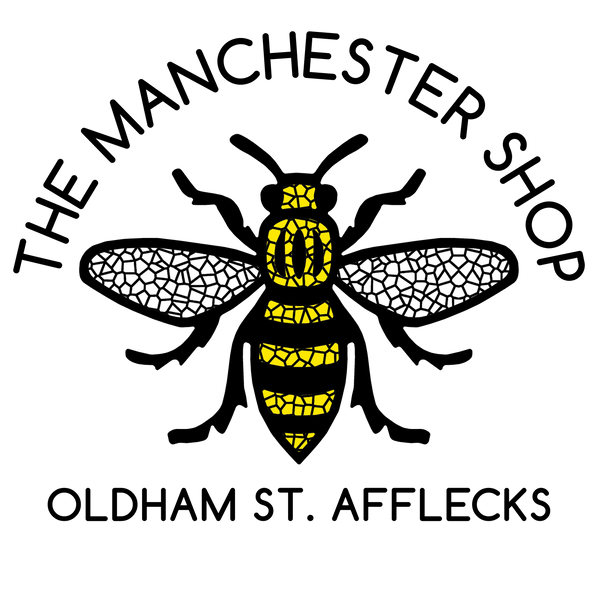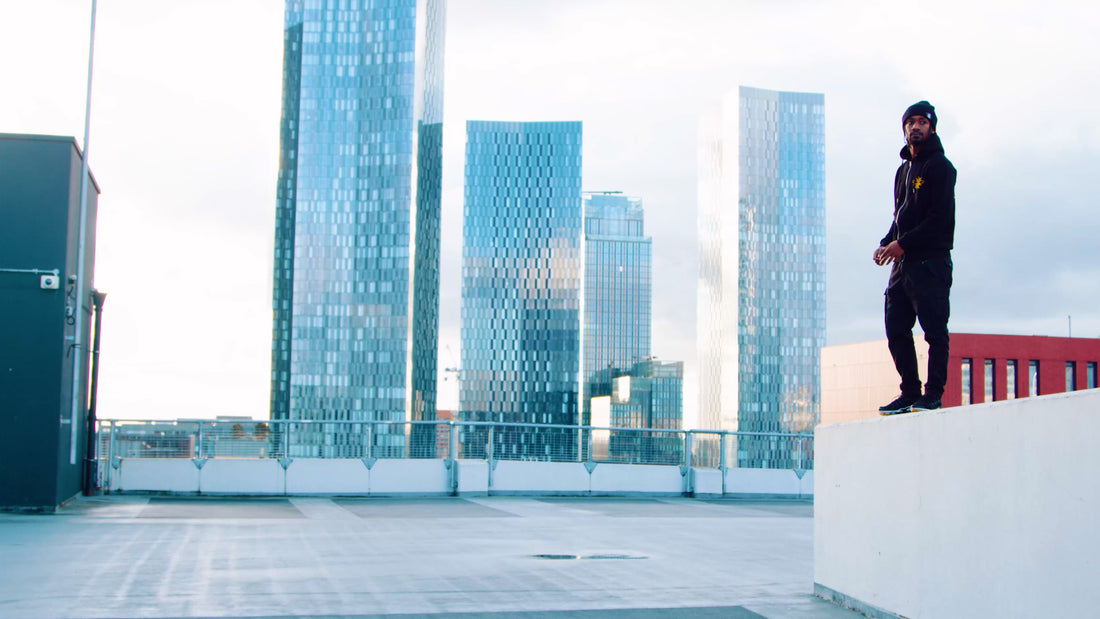
What Is Manchester Famous For?
Share
 ChrisClarke88, CC BY-SA 4.0, via Wikimedia Commons
ChrisClarke88, CC BY-SA 4.0, via Wikimedia Commons
Whether you're born and bred in this fine city, or you're thinking of visiting but want to know what it's all about, Manchester has so many fantastic things it's well known for. From the incredible, big and bold architecture to the slightly-obscure pop culture anecdotes, here's our rundown of what makes Manchester so special.
10 Things Manchester Is Famous For:
The Manchester Bee
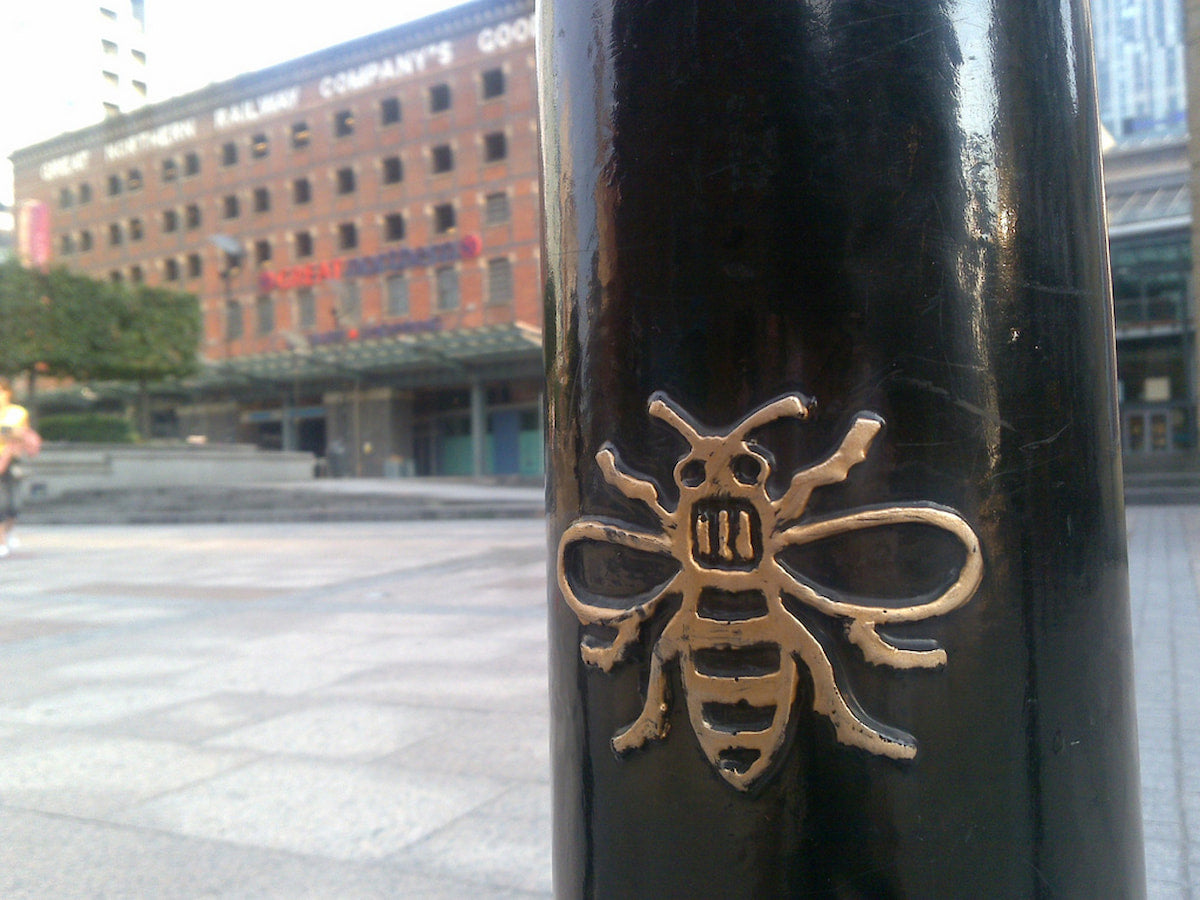
Frankie Roberto from Manchester, UK, CC BY 2.0, via Wikimedia Commons
Come to visit Manchester and you'll see it everywhere, on the bollards, dustbins, even in mosaics on the town hall floor. But why does Manchester love the bee so much? What does the Manchester bee mean?
In 1853, Manchester achieved city status. Seven bees were incorporated into its coat of arms to symbolise Manchester's influence through the industrial revolution. The city was dubbed a “hive of industry” and its citizens “worker bees.” The Manchester bee now proudly symbolises the City of Manchester and its unique people.
Although the bee has been a Mancunian icon since the 1800s, it's been fully embraced by proud Mancs over the last decade or so. From local businesses adopting the bee as part of their branding, to people getting bee tattoos, we're pretty creative with our ways to show love for the bee. Even with a population of nearly 3 million people, we know when to come together as a community and work together to keep going… like bees!
See our Complete Guide to the Manchester Bee article for more on our beloved bee.
Looking for the perfect gift for the bee lover in your life? Check our our bee gifts for her, and bee gifts for him collections.
Football
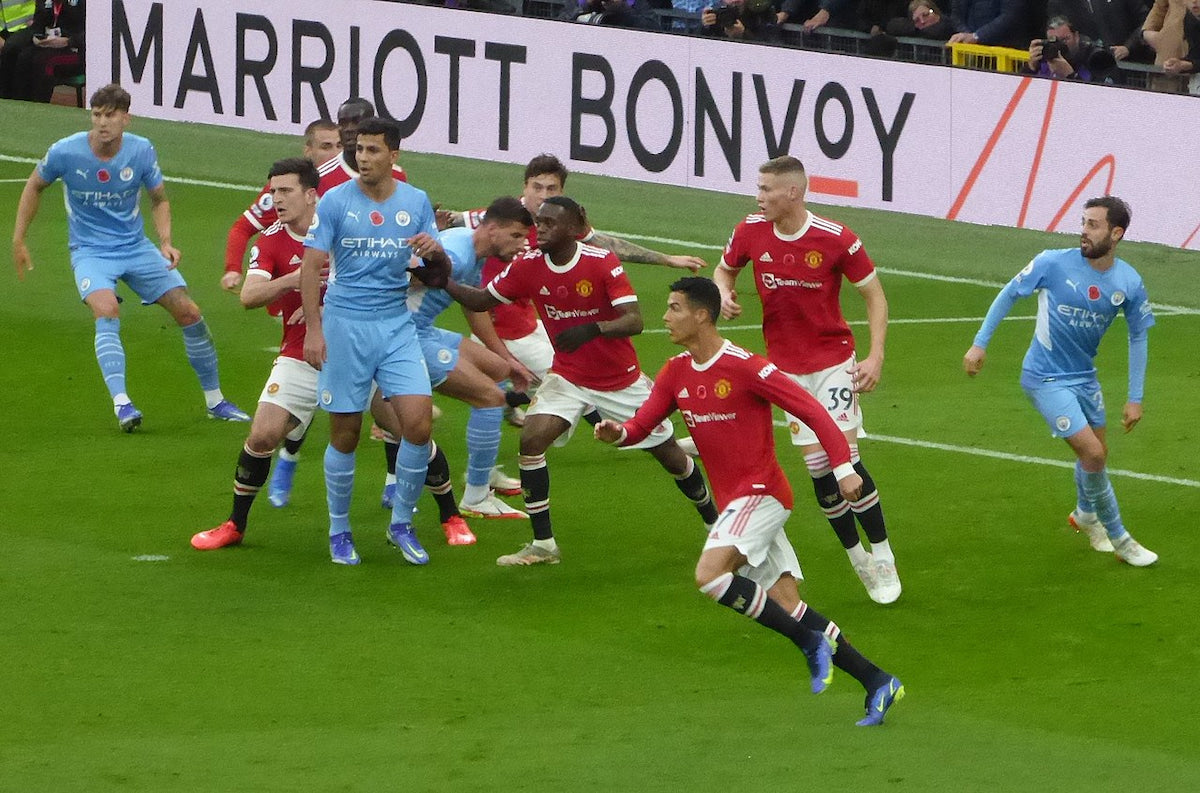
Ardfern, CC BY-SA 4.0, via Wikimedia Commons
Travel anywhere in the world as a Manc and when you tell anyone where you're from it's followed up with the same question – “Red or blue?” It comes as no surprise that our biggest international export is football, in the shape of our two biggest clubs, Manchester United and Manchester City. These two Premier League behemoths divide Manchester - literally! City's Etihad ground in the north, United's Old Trafford in the south, both just outside the city centre.
United and City fans are both notoriously passionate about their teams, and with good reason. To date, Manchester United have won a record 20 League titles, 12 FA Cups, 5 League Cups, and a record 21 FA Community Shields, whereas Manchester City have won 8 League titles, 6 FA Cups, 8 League Cups, 6 FA Community Shields and 1European Cup Winners Cup.
While the rivalry may be fierce, whether you're red or blue, we're “a city united” in our love for the beautiful game.
Feel like putting your support behind a smaller Manc team? F.C. United of Manchester currently play in the National League North and are owned by 5,000 of their most dedicated supporters.
Manchester's love of football goes further back than red versus blue too! Newton Heath LYR Football Club (later to be renamed Manchester United, you might have heard of them) were part of the first English football league The Combination, established in 1888.
See our full article on The History of Manchester Football for more information.
Music
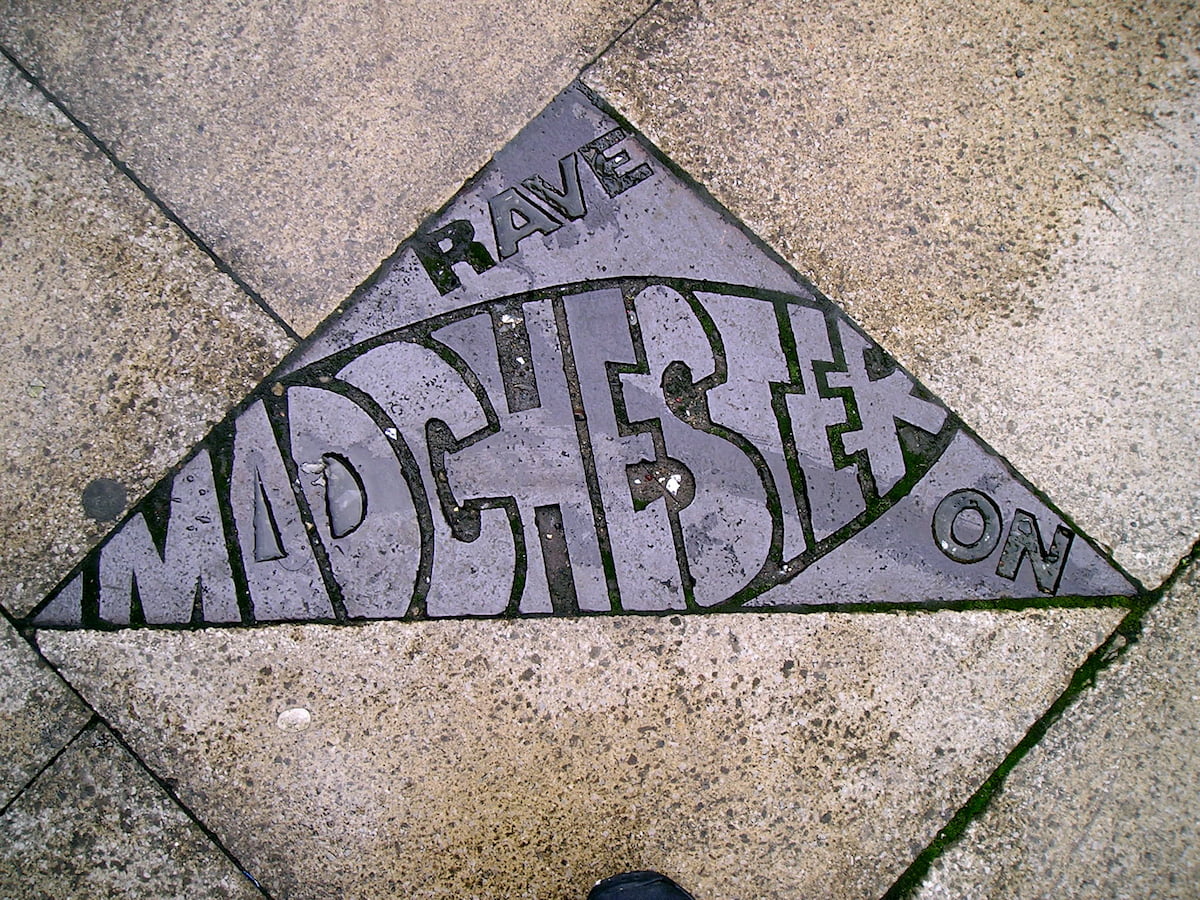
Image Credit: Karen Bryan
Listen to any good indie band from the last 30 years, and it's guaranteed they're either inspired by or are a band from Manchester.
Whether it's jangly guitar-pop from The Smiths, synth-wave electronica from New Order or the smooth blue-eyed soul of Simply Red, you can hear the influence everywhere.
Two of the most notorious musical “urban legends” happened right here at our very own Free Trade Hall – Bob Dylan was heckled with the cutting “Judas!” when “going electric” in 1966, and the Sex Pistols played an iconic gig there in 1976 - credited with being the genesis of a lot of Manchester's most famous bands, including The Smiths, Magazine, Joy Division and The Fall.
It would be understandable to expect that the Manchester musicians would all sound the same and maybe have a “Manchester sound,” - but a diverse city creates diverse music! Although Mancunians are probably most well known for the wave of Britpop-era indie bands in the ‘90s, the city was also at the forefront of the UK's rave and dance music scene with the Haçienda nightclub. The city was awash with ravers and clubbers, looking to spend all weekend having it large to house music and experiencing all things “Madchester.”
Unfortunately the Haçienda lost its entertainment licence in June 1997 and closed its doors forever, as so excellently documented in the fantastic Steve Coogan film 24 Hour Party People.
Want to see what's left of the Haçienda? Visit the site now and you'll find a block of somewhat un-inspirational apartments. However, head down the road to The Manchester Museum of Science and Industry and you'll find various Haçienda and Factory records artefacts, including the main loading bay doors from the club, and a wide array of posters, fliers and props.
From Stone Roses to Oasis, Happy Mondays to Inspiral Carpets, Elbow to Take That, Manchester makes the best music in the world.
See our full article, What Was Madchester? for much more information on the phenomenon that was Madchester.
Scientific breakthroughs
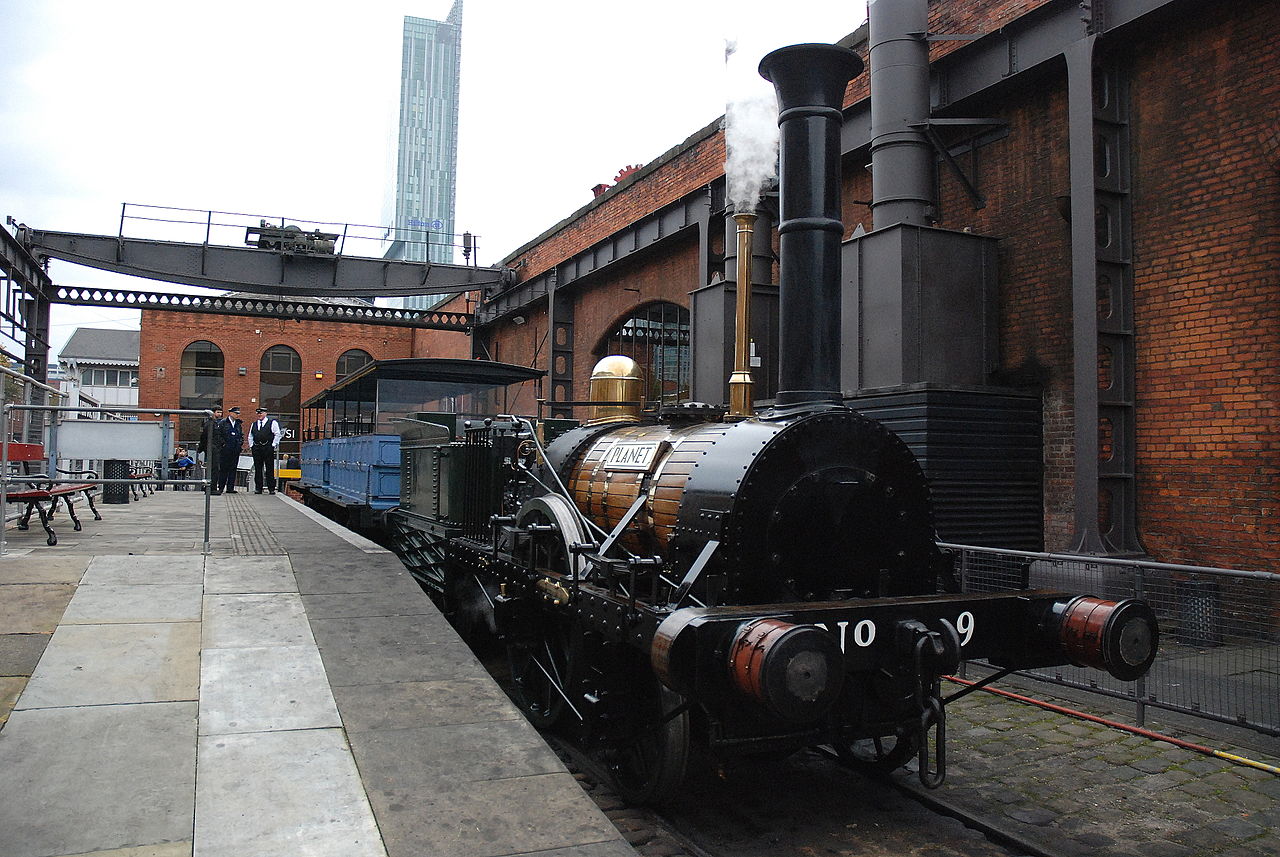
Paul Hermans, CC BY-SA 3.0, via Wikimedia Commons
You already know that the people of Manchester work hard, so it should come as no surprise that so many amazing moments in science and engineering happened in Manchester!
Due to the industrial revolution, Manchester's population and influence rapidly grew and the city became a centre for new discoveries, scientific breakthroughs and technological developments in engineering. In fact, it's often been said that “What Manchester does today, the rest of the world does tomorrow.”
You can find out all about all these incredible achievements at our very own Science and Industry Museum, but some of the most notable are:
- Ernest Rutherford first split the atom here in 1917
- Frederic C. Williams, Tom Kilburn, and Geoff Tootill developed the world's first stored-program computer in Manchester in 1948 (with assistance from Alan Turing)
- Andre Geim and Konstantin Novoselov isolated the first graphene in 2004, all at the University of Manchester
- In 1978, the first “test-tube baby” was born at Oldham General Hospital pioneering IVF birth, achieved by research carried out by Manchester's own Robert G. Edwards. He was awarded the Nobel Prize in Physiology or Medicine in 2010.
- South of Manchester, the Lovell telescope at Jodrell Bank was used to track the Sputnik satellites in 1957.
We even have a planet named after us! 758 Mancunia is a minor planet orbiting the Sun. It was discovered in 1912 by H. E. Wood, a Mancunian.
Manchester's pursuit of scientific discovery didn't stop in the 20th century. With inspirational figures like Oldham's Professor Brian Cox being a particle physicist at the University of Manchester, constant investments and growth in sites like Manchester Science Park and fantastic city-wide events like Manchester Science Festival, the next Ernest Rutherford could already be out there!
See our full article on Manchester's Impact on Science for more information.
Victorian architecture
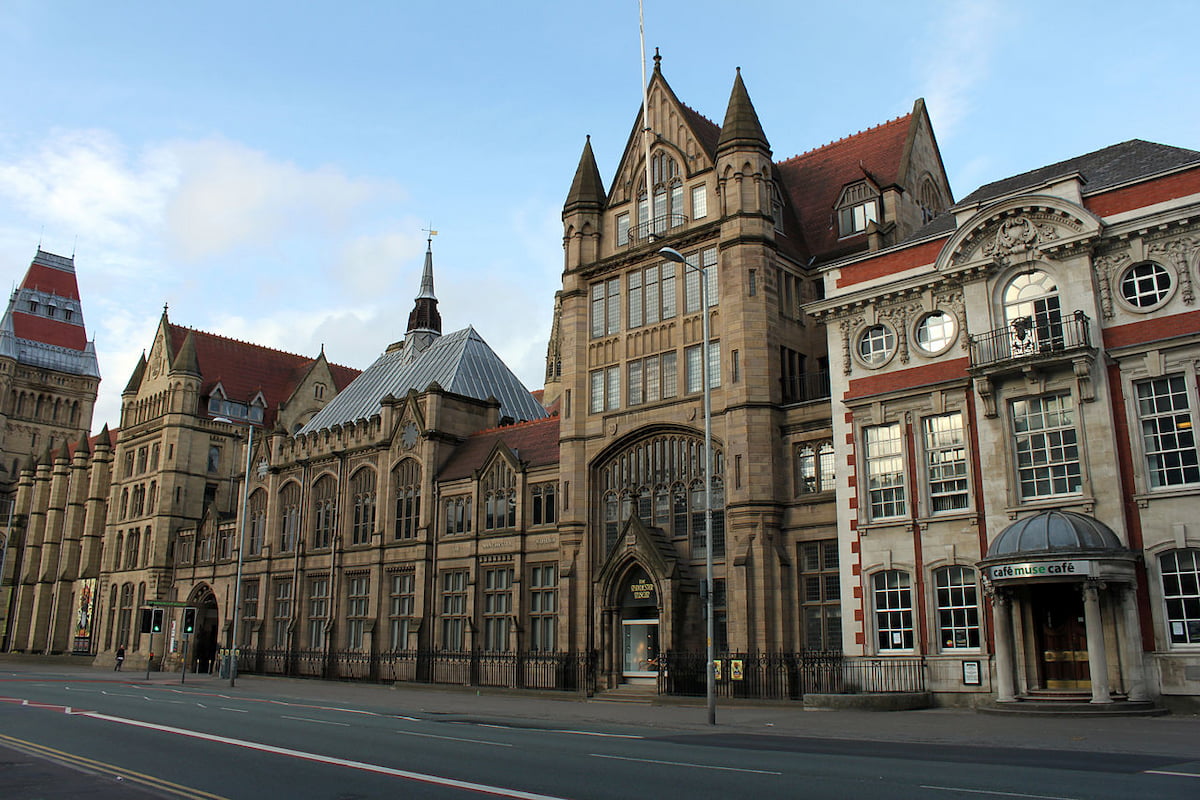
DrPhoenix, CC BY-SA 3.0, via Wikimedia Commons
If you love red brick warehouses, tall mill chimneys and railway viaducts, Manchester is the place for you! Although we've got our fair share of shiny glass skyscrapers popping up, we take pride in the beautiful old buildings built by our Victorian ancestors.
Head out to Ancoats with a coffee on a cold day and enjoy a walk around the marina. You'll get to enjoy the beautiful old cotton mills, narrow cobbled roads and the spot where the Rochdale canal meets the Ashton Canal (mind the geese!)
One of the architectural highlights in Ancoats is a building that perfectly blends the old and the new – Ancoats Dispensary. A well-loved red brick building built in 1874, the former hospital fell into disrepair during the 20th century, but has been given a new lease of life by being renovated into homes while preserving the original structure.
You might be wandering around thinking “that tiny alleyway sure does look familiar…” Well, you're probably onto something! The architecture of Manchester is very often used in film and TV, from the docks and pubs in Peaky Blinders (head to Castlefield to go back to 1930s Birmingham) to the “brownstone” style facias in Captain America (take a look around Stevenson Square for 1920s New York) or a snapshot of a derelict industrial Thatcher's Britain in Life on Mars (get over to north Ancoats for 1970s London.)
For more on Manchester's architecture, see our article 50 Famous Manchester Landmarks.
The Industrial Revolution
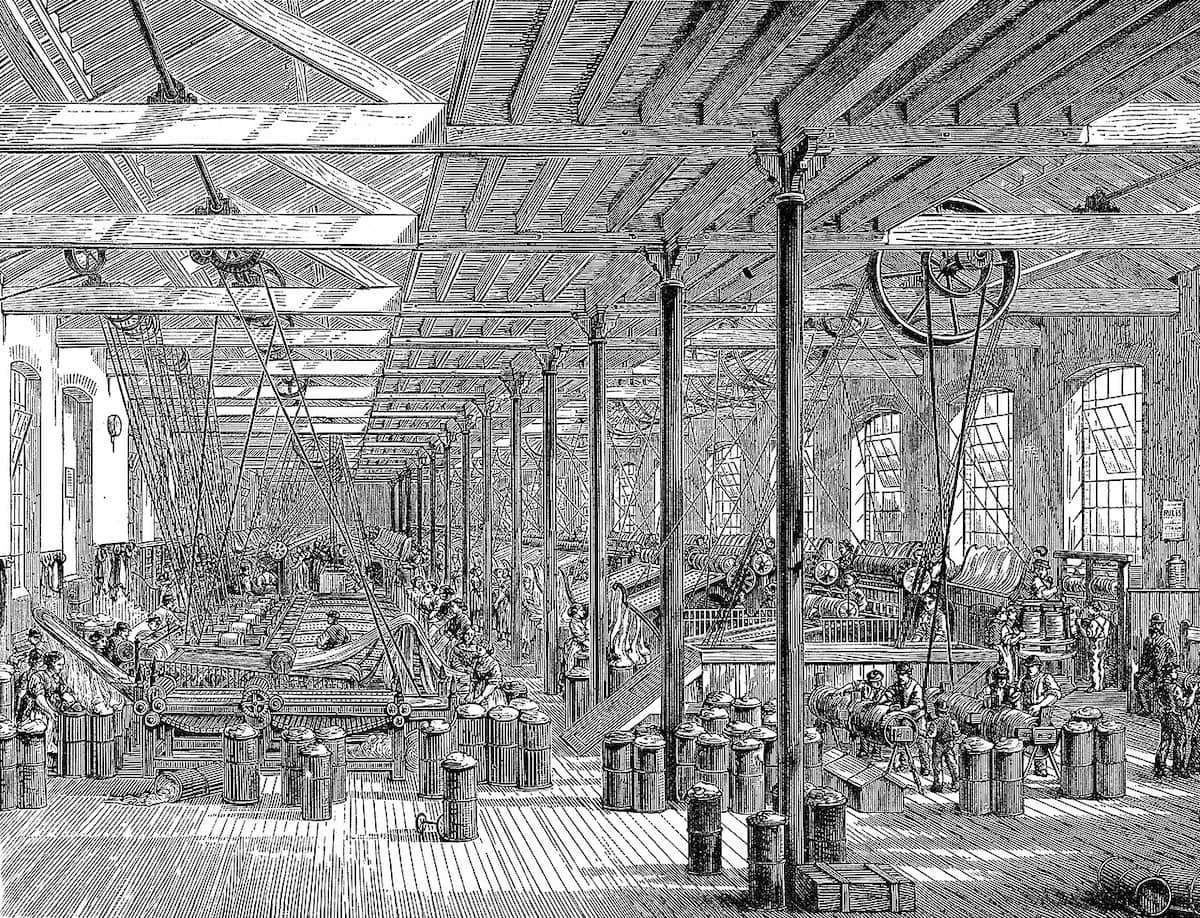
duncan1890, CC BY-SA 4.0, via Wikimedia Commons
The history of Manchester is truly synonymous with the industrial revolution and even after 200 years, we can still see the evidence of that, from the previously mentioned city centre mills to the iconic Manchester bee awarded in 1853.
The mills that you can see all around Manchester were responsible for manufacturing cotton textiles to be distributed all over the world, which is why the city acquired the nickname Cottonopolis. Canal boats were loaded with cotton, and made their way to the Liverpool Docks via Manchester Ship Canal; built in 1893 and the largest ship canal in the world at the time.
From here, textiles made in Manchester were sent all over the world. In fact, this has still left its mark today; in Australia and New Zealand, the slang for bedsheets is Manchester!
The industrial revolution truly made Manchester into the city it is today. Due to massive urbanisation, the population of Manchester grew from 10,000 in 1717 to 2.3 million in 1919! Attracted by the prospect of work, people flocked to the city and the population of Ancoats where a lot of the cotton mills were located increased from 11,000 in 1831 to 56,000 in 1861.
We also wouldn't have our railways (the Liverpool and Manchester Railway was the first inter-city railway in the world and still runs from Manchester Victoria Station to Liverpool Lime Street Station), our canal system or concrete!
You'll know when you're in Manchester that the “graft and grind” lifestyle is real here - and that's left over from the industrial revolution! It's almost like the soul of the city, and it comes from our ancestors. We work hard and we work together, like worker bees in the hive.
For more on this, see our comprehensive article Manchester & The Industrial Revolution.
Coronation Street
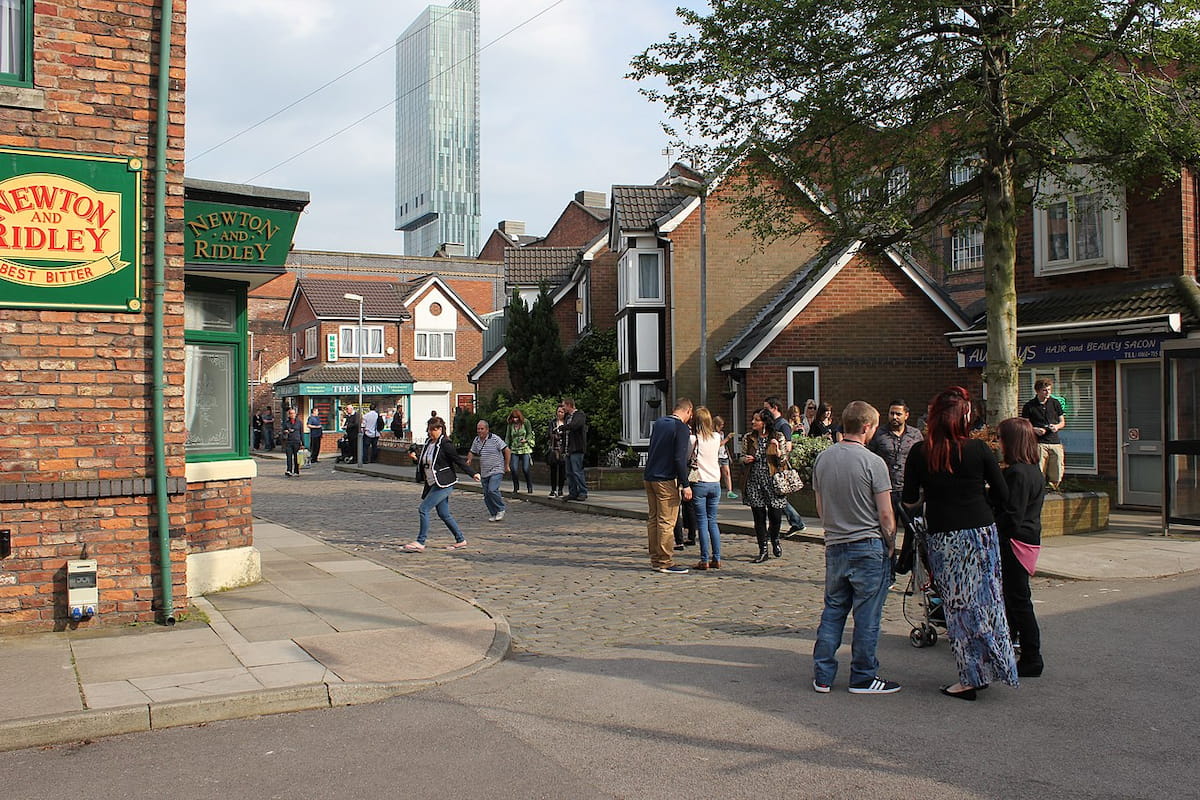
vagueonthehow from Tadcaster, York, England, CC BY 2.0, via Wikimedia Commons
It's become part of the daily routine for millions of people – kettle on, feet up, Corrie time! With over 10,000 episodes and 60 years on air, Coronation Street has become the world's longest-running television soap opera. The TV show affectionately nicknamed Corrie has been filmed in Manchester since it was first broadcast in 1960. That first episode starred Ken Barlow (played by William Roache) who is still in the soap today!
Coronation Street isn't just the nation's favourite soap, it has been critically recognised and nominated for nearly 300 awards, winning 9 BAFTAs and 22 National Television Awards to date. It's known for blending hard-hitting and dramatic storylines with the occasional bit of tongue-in-cheek humour us Northerners are known for, to create a truly unique down-to-earth bit of telly.
The plots on Coronation Street have a reputation for being groundbreaking and encouraging wider conversation about social issues, from Hayley Cropper, a trans-woman depicted as someone who was strong and loved by all (the first ever transgender character in a British soap), to Sarah Platt's teenage pregnancy which was praised by the UK government for raising the issue in front of a mass audience.
Coronation Street gives us all the things we love about Manchester - it's easygoing, friendly, and sometimes a bit sill Things can get pretty dramatic, but we work our way through it, move on and make a cup of tea.
Fancy seeing the cobbles for yourself? You can take a tour of Coronation Street! Have a wander around the set just outside the city centre at MediaCity - you might even bump into your favourite character!
If you want to read more about Corrie, check out our full article The Complete Guide To Coronation Street.
Women's suffrage
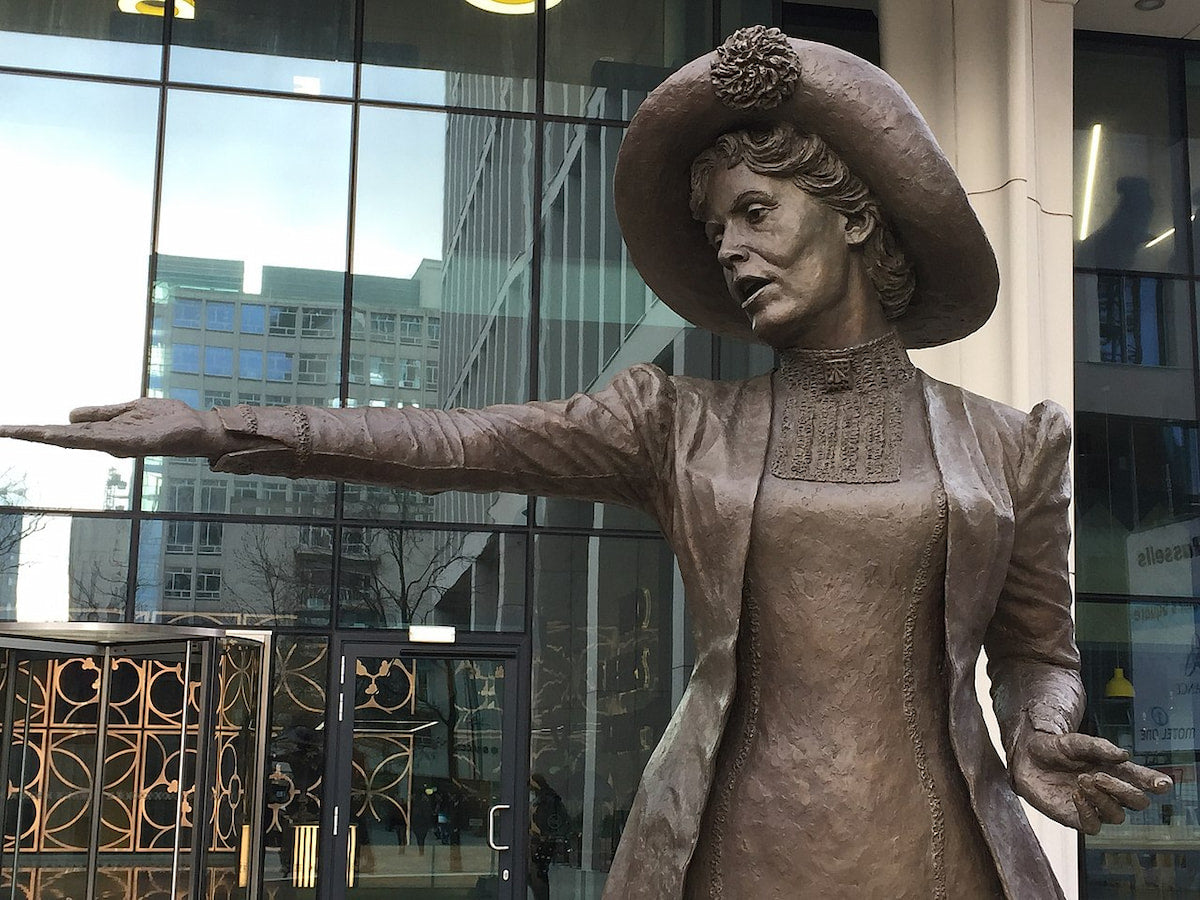
Delusion23, CC BY-SA 4.0, via Wikimedia Commons
One of the lesser known facts about Manchester is that the women's suffrage movement was developed here, mainly due to the hard work of one woman - Emmeline Pankhurst.
Born in Moss Side in 1858, Emmeline was introduced to women's suffrage from an early age by her politically active parents and was attending public meetings about women's voting rights from the age of 14.
After years of activism but getting any minds and laws changed, Emmeline founded the Women's Social and Political Union, an organisation open only to women and focused on direct action to win the vote.
With the motto “Deeds not Words,” the group made speeches, gathered petition signatures and organised rallies to fight for their cause. There were also some more extreme actions which at one point ended in Emmeline's imprisonment, an act she defended by stating “We are here not because we are law-breakers; we are here in our efforts to become law-makers." Emmeline died in 1928, the same year women's right to vote was won.
The actions of Emmeline are recognised today not only by everyone being able to legally vote, but also by the Pankhurst Trust (Incorporating Manchester Women's Aid) a charity based at Emmeline's home where she established WSPU.
“We work together to ensure the powerful story of the women who won the vote continues to inspire us all to challenge gender inequality, and to ensure that those suffering from domestic violence and abuse get the confidential help they need.”
We're proud to support the Pankhurst Trust by donating percentages of sales from our Womanchester range to them.
Love all things Emmeline? You can also visit her statue at St Peter's Square near Manchester Library. The statue was placed in this city centre location on 14th December 2018, the 100th anniversary of some women voting for the first time in a British General Election. The day also held a march from the Pankhurst Trust to the statue (much like one Emmeline might have orchestrated herself!) and was unveiled by her great-granddaughter Helen Pankhurst.
Read our full article Manchester and The Suffragette Movement for more on the Suffragettes in the northern powerhouse.
Afflecks

Ivor Josephson / Afflecks Palace
For 40 years, the teens of almost all subcultures from all over Manchester have spent their weekends at the same place - Afflecks! This independent shopping emporium is the place that we're proud to call our home. With four floors of everything you could possibly imagine, from tattoo studios to LGBTQ book shops, thousands of people from all over the world have flocked to Afflecks to browse through this sprawling marketplace since it was first opened in 1982.
Afflecks gives creatives the opportunity to make their business dreams come true - it's the perfect first step for small businesses and artists. But a lot of traders love the independent nature of Afflecks and will stay there for years and years! It's for that reason we at The Manchester Shop have called it our home since 2016, and our sister shop Luna has been there since 1997.
We love it because it's a place where the misfits can go to fit in, the searchers can go to find what they're looking for and the people who aren't from Manchester can see what we're all about.
Need something a bit weird but not sure where to find it? Afflecks is the place for you!
Want to see what Afflecks has to offer? Check out their website, which has a list of all their traders and details on how to find them in the heart of the Northern Quarter.
Our Complete Guide To Afflecks Palace article has the full history of this iconic building and our home, if you'd like to learn more.
People of Manchester

When trying to think of the things that make Manchester special, we realised that it's more than just the places and things - it's the people!
We're talking about the bloke you'll get chatting to down the pub on a Sunday afternoon, the woman next door that baked you a loaf during the lockdown, and the people who work hard to get us around town and keep everything working as smoothly and brilliantly as it does. They're the Mancs that make us smile!
There are some fantastic notable Mancunians who inspire us that are worth a shout:
- Frank Sidebottom - a daft bloke who sang silly songs and taught us to keep being creative and do the thing you love (even if that's appearing on Channel M at 3 am while wearing a giant papier mache head.)
- Sunny Lowry - Born in Longsight and claimed to be the first British woman to swim the English Channel in 1933 after training at the iconic Victoria Baths in Manchester.
- Anthony Burgess - Manchester-born and educated author, poet, playwright, musician, linguist, translator and critic, known for the novel A Clockwork Orange.
- Frank "Foo Foo" Lammar - legendary drag act born in Ancoats, who reportedly raised £4million for charity including Royal Manchester Children's Hospital.
- Caroline Aherne - BAFTA-winning actress who had us laughing all the way through the 90s and 00s as Mrs Merton or in the Royale Family.
Obviously we're very biased, but it turns out that all our favourite people are Mancs! We're so inspired by all these terrific Mancunians, that we created a range of products based on Manchester Legends, including a print, mug and coaster. They make perfect gifts for anyone who loves the people of Manchester as much as we do!
If you're a people lover, you might be interested in our 60 Most Famous People From Manchester article!
Other notable Manchester Facts
Just because everyone loves a “did you know…” moment, we thought we'd add some other honourable mentions…
- The nation's favourite fruity cordial Vimto was created in 1908 in Manchester. Originally sold as a health tonic, it has been sold for over 100 years to 73 countries worldwide.
- Marks & Spencer was established in 1894 at Leeds Kirkgate Market, but the first high-street store was opened in Manchester.
- As well as being the favourite reading space for Karl Marx, Chetham's Library founded in 1653 is the oldest public library in Britain. It's also home to the Manchester Scrapbook, gifted to the library in 1838.
- The Vegetarian Society was established by Reverend William Cowherd in 1800s Manchester. “If God had meant us to eat meat then it would have come to us in edible form, as is the ripened fruit”
- John Rylands Library in the city centre holds what is believed to be the earliest extant New Testament text. It measures 3.5 by 2.5 inches and dates back to 100–150 CE, making it nearly 2000 years old!
Loving all the fabulous things Manchester is famous for? Check out The Manchester Shop website for all things Manchester-related, from bee mugs and prints to t-shirts and bee jewellery.
